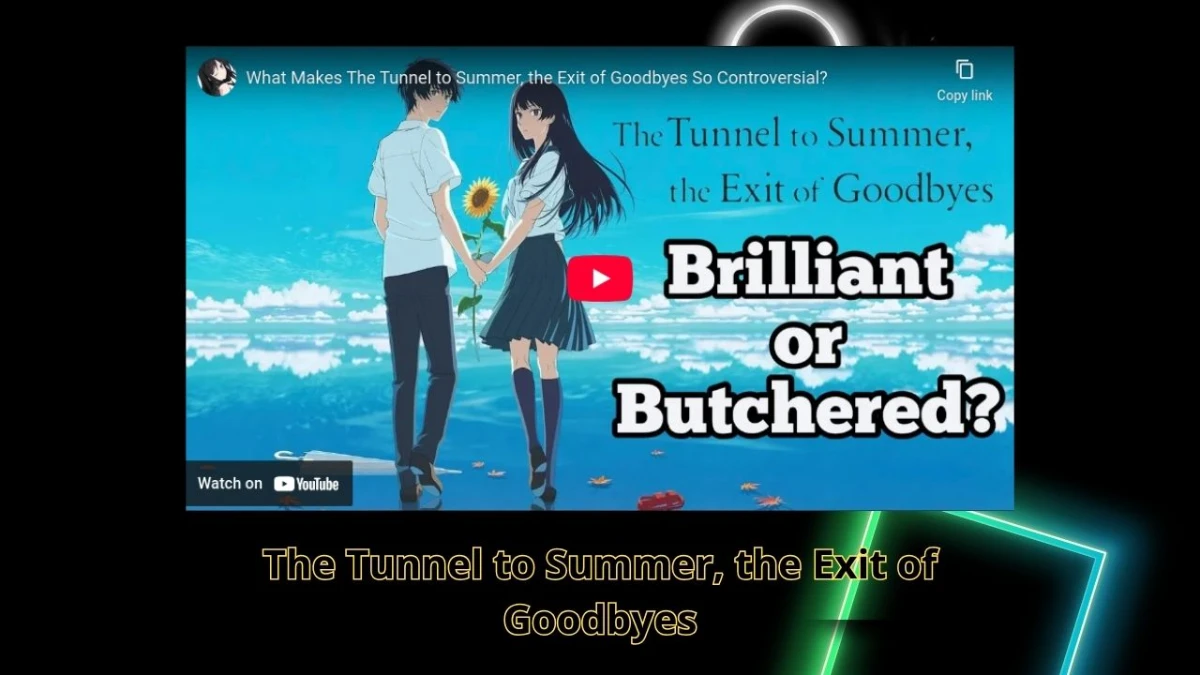The Tunnel to Summer the Exit of Goodbyes emerges as a poignant exploration of time’s elasticity and human connection, masterfully blending speculative fiction with emotional depth. This acclaimed anime film adaptation of Mei Hachimoku’s novel captivates audiences through its delicate balance of melancholy and wonder, inviting viewers into a world where a mysterious tunnel offers a chance to rewrite the past. With its universal themes of love, loss, and the weight of regret, this visually stunning resonates deeply with both anime enthusiasts and those seeking thought-provoking narratives about life’s irreversible moments.
The Tunnel to Summer the Exit of Goodbyes : Synopsis & Core Premise
Set in a quiet coastal town, the story follows Kaoru Tono, a teenager burdened by guilt over his sister’s mysterious disappearance years earlier. He discovers a hidden urashima tunnel—a legendary passage where time flows differently inside than outside. Entering with his classmate Anzu Hanashiro, who harbors her own painful secrets, they experience time distortion where hours inside equal mere minutes in the outside world. As they navigate this temporal anomaly, confronting their pasts while facing the tunnel’s dangerous consequences, the narrative explores how far one might go to alter painful memories and whether some goodbyes are truly necessary for healing.
Themes & Motifs
Time, Memory, and Regret
The tunnel serves as a powerful metaphor for how we process grief and regret, with its time-bending properties reflecting the subjective nature of memory. The film suggests that while we might wish to revisit and change the past, doing so could fundamentally alter who we’ve become. Through Kaoru’s journey, we see how regret can become a prison, yet also how confronting it—rather than escaping it—offers the only true path forward. The narrative poses profound questions about whether erasing painful memories would actually bring peace or merely create different kinds of loss.
Character Dynamics and Growth
Kaoru and Anzu’s relationship evolves from hesitant companionship to profound mutual understanding, their shared vulnerability creating a space for emotional honesty neither has experienced before. Their contrasting approaches to the tunnel—Kaoru’s desperate hope to change the past versus Anzu’s more measured perspective—create compelling tension that drives character development. Supporting characters, including Kaoru’s emotionally distant father and Anzu’s protective friends, provide necessary context that highlights the isolating nature of unresolved grief and the healing potential of genuine connection.
Visual/Atmospheric Storytelling
The film employs breathtaking visual contrasts between the tunnel’s ethereal, dreamlike interior—characterized by soft blues and luminescent flora—and the grounded, sun-drenched realism of the coastal town. Director Tomohisa Taguchi uses light as a narrative device, with the tunnel’s shifting illumination reflecting the characters’ emotional states. Sound design plays an equally crucial role, with the muffled silence inside the tunnel emphasizing its otherworldly nature, while the film’s minimalist piano score underscores moments of revelation without overwhelming the emotional weight of each scene.
Production & Reception
Creative Team, Adaptations, Release Context
Adapted from Mei Hachimoku’s award-winning light novel, the film was directed by Tomohisa Taguchi (known for his work on Persona 3 The Movie) with animation production by CLAP, a studio gaining recognition for its distinctive visual storytelling. Screenwriter Makoto Uezu masterfully condensed the novel’s complex temporal mechanics while preserving its emotional core. The film premiered at the Annecy International Animation Film Festival before its theatrical release in Japan in August 2022, with international distribution following through Crunchyroll and select screenings.
Critical Response & Audience Takeaways
Critics praised the film for its mature handling of grief and its refusal to offer easy solutions to complex emotional pain. Animation News Network highlighted its “stunning visual poetry that transforms abstract concepts into tangible beauty,” while The Japan Times commended its “understanding that some wounds can’t be erased, only carried differently.” Audience reception has been equally positive, with particular appreciation for how the film respects younger viewers’ emotional intelligence while providing layers of meaning for adult audiences. The soundtrack by Harumi Fuuki received special recognition for enhancing the narrative’s emotional resonance without becoming manipulative.
Where to Watch/Read
The film is currently available for streaming on Crunchyroll with multiple language options, including English subtitles and dubs. Physical media releases include Blu-ray editions from distributors like GKIDS in North America and Anime Limited in Europe, featuring behind-the-scenes content and director commentary. The original light novel by Mei Hachimoku is available in English through Yen On, with a manga adaptation illustrated by Koudon also published in English by Yen Press. Libraries in major cities often carry both the novel and manga editions for those preferring physical borrowing options.
FAQs
The tunnel’s altered time flow symbolizes how grief can make moments feel simultaneously frozen and accelerated—how painful memories can dominate our present while life outside continues moving forward. It physically represents the psychological experience of being “stuck” in the past.
While animated, the film deals with mature themes of loss and regret that may require emotional maturity to fully process. It’s generally recommended for viewers 12 and up, with parental guidance suggested for younger audiences due to its emotional intensity.
Unlike many time-travel stories that focus on changing historical events, this film uses its time mechanics as a framework for internal character exploration rather than plot manipulation. The emphasis is on emotional consequences rather than paradoxes or adventure.
The conclusion offers emotional closure while respecting the ambiguity of real-life grief. Rather than providing neat answers, it suggests that healing comes not from erasing pain but from integrating it into one’s ongoing story.
Conclusion
The Tunnel to Summer the Exit of Goodbyes stands as a masterclass in animated storytelling that transcends genre expectations, offering profound insights into the human condition through its delicate exploration of time, memory, and connection. Its visual poetry combined with emotional authenticity creates an experience that lingers long after viewing, inviting reflection on our own relationships with past regrets and the goodbyes that shape us. This film will particularly resonate with viewers who appreciate character-driven narratives that honor complexity while delivering genuine emotional impact, much like the layered storytelling found in The Apothecary Diaries analysis. For those seeking animation that challenges both heart and mind, this remarkable work proves that some stories—like some tunnels—lead us exactly where we need to go, even if the journey isn’t what we expected.

